AESTHETIC PLASTIC
RECONSTRUCTIVE
SURGERY
SEBASTIEN GARSON M.D
HAIRS
This fact sheet was developed under the aegis of the French Society of Plastic Reconstructive and Aesthetic Surgery (SOF.CPRE) as an addition to your initial consultation, to try to answer all the questions you can ask yourself if you plan to use surgery baldness. The purpose of this document is to provide you with all the necessary and essential elements of information to help you make your decision with full knowledge of the facts. Also you is it advisable to read with the greatest attention.
• DEFINITION OBJECTIVES AND PRINCIPLES
Baldness is particularly resented, and resented both in men than in women. The emergence of micro-grafts has transformed this surgery. It can, indeed, reduce the importance of
interventions and residual scarring. However in the area of baldness, there is no single technique that can be applied to all cases.
The principle of the treatment is the same: take hair in the crown area, where we are assured that they will never fall, to transpose in areas of the forehead and the tonsure.
Currently, four types of techniques can be used:
- The Micrografts
- The FLAP
- The discounts tonsure
- LIFTING the SCALP
All these methods can be combined in the same patient. It should thoroughly analyze each case and you take into account several parameters: the importance of baldness, flexibility scalp, hair quality, the patient's wishes. Depending on its age and scalability of baldness, we can deduce the strategy best suited to each case.
Your surgeon should have experience of all these techniques to advise you the best in your case.
• BEFORE THE OPERATION
A usual preoperative assessment is conducted in accordance with regulations. If general anesthesia is required, the doctor
anesthetist will be seen in consultation at the latest 48 hours before the procedure.
No medication containing aspirin should be taken within 10 days before surgery.
• TYPE OF ANESTHESIA AND CONDITIONS OF INTERVENTION
Type of anesthesia:
Most procedures can be performed under local anesthesia.
Terms of admission:
The procedure can be done in "ambulatory", that is to say with out the same day after a few hours of monitoring.
However, in some cases, a short hospital stay may be preferable. The input is then carried out in the morning (or sometimes the day before in the afternoon) and the output is allowed the following day.
• INTERVENTION
Each surgeon adopts a technique of its own and it adapts to each case to obtain the best results. The procedures are different depending on the type of technique used:
- The Micrografts: the practitioner fee in the crown a strip of scalp long 8 to 10 cm wide and 1 to 2 cm, which "will be debited" into small pieces, each containing one to three hair
(Micro-grafts) or 4-8 hair (minigrafts). Many perforations are made in the balding grafts for implantation region. A small scab will form on each implant fall after about two weeks leading to the fall of the implanted hair that will push to the third month.
Several sessions are needed on the same receptor site for a suitable density. The procedure is very light and is performed under local anesthesia.
- The FLAP: the process involves removing a long strip of 15-18 cm and a width of about 3 cm with a pedicle necessary vascularization is not cut and rotated around the pedicle to be placed in the frontal region. This is the only method which allows a single operation to provide a high density of hair in the frontal region. But the flap technique has in some risks that need to be explained by your surgeon. The procedure is performed under local anesthesia, but a few days may be necessary before resuming work.
- The tonsure DISCOUNTS: the practitioner removes a portion of the bald area and closes immediately playing on the elasticity of the scalp.
Usually an area of 10 to 12 cm long and 3-4 cm wide can be removed. This technique finds its interest in the region of the tonsure and in patients with good elasticity of the scalp. The procedure is done under local anesthesia and allows early resumption of activities. It can be repeated two or three times a few months apart.
- The LIFTING THE SCALP: it is a technique that combines heavier at the same time reducing operating wide tonsure with one or two flaps to cover the frontal region. Such a method can be used to cover some large balding two operating time only. It is most often performed under general anesthesia and requires a rule to stop work 8 to 10 days.
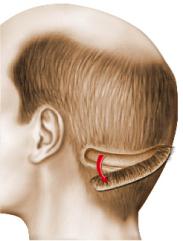
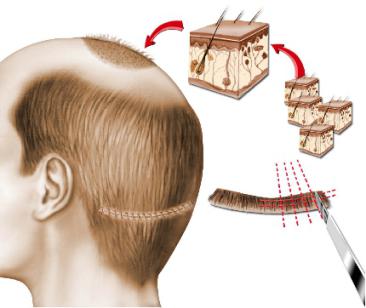
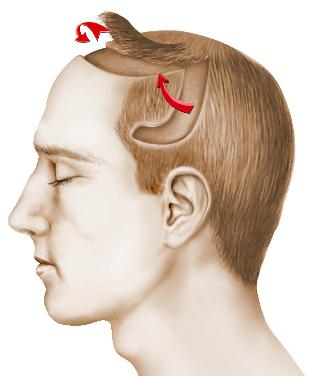
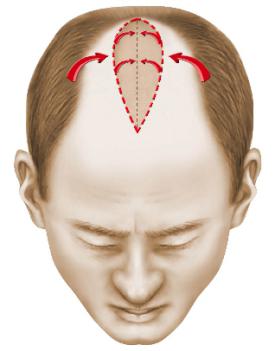
AFTER THE INTERVENTION: THE OPERATING SUITES
There must be a stop job size of 4 to 8 days. For micrografts, forms a small bar on each graft falling between 8 to 10 days. The transplanted hair
fall with the crust and then push between the second and third months. They grow to 1 cm
months. In cuts, shreds and lifting the scalp, the hair does not fall and son will be removed to the eighth day.
Shampoos are generally allowed 48 hours after the operation.
The practice of sport can be resumed gradually from the fourth postoperative week.
The type of headache pain may persist for a few days, they will be relieved by prescription painkillers.
The postoperative course is essentially marked by the appearance of edema (swelling) and ecchymosis (blue) whose magnitude and duration are highly variable from one individual to another.
• THE RESULT
Within 3 to 6 months is needed to assess the results of micro-grafts and in all cases at least two interventions will be needed to obtain a sufficient density of hair.
For other techniques, the result is immediate.
• FAULTS OF THE RESULT
called reasonably expect. This is a lack of density after Micrografts or uneven distribution of hair after a flap
• POSSIBLE COMPLICATIONS
Correction of baldness, although carried out mainly for aesthetic reasons, not least is a real surgery, which involves
risks associated with any medical procedure, however small it may be. We must distinguish the complications of anesthesia and those related to the surgery.
* For general anesthesia, during the consultation, the anesthetist inform himself (the) patient (e) of anesthetic risks. You should know that anesthesia in the body sometimes unpredictable, and more or less easy to control: the fact of using a fully qualified anesthetist working in a surgical context, that the risks are now almost statistically insignificant.
You should know, indeed, that the techniques, anesthetics and monitoring methods have made tremendous progress over the past twenty years, providing maximum security, especially when the operation is performed outside of the emergency and in a healthy person.
* Regarding the surgery: choosing a qualified and competent plastic surgeon, trained in this type of surgery, you limit these risks, without removing them completely.
Fortunately, the real complications are rare following a procedure performed in the rules. In practice, the vast majority of happens without any problems and the patient (s) are fully satisfied (s) of their income.
However, despite their rarity, you should be aware of possible complications:
- Hair loss 2-3 weeks after surgery on the outskirts of the grafted area is very common. It is temporary rule.
- Bruising: mostly harmless, they can be removed if they are too large.
- Infection: Outstanding during an operation of the scalp, apart from a few micro-abscesses developed on a stitch and easily handled by small local care.
- Abnormal healing: very rare at the donor graft areas.
- Epidermal Cyst: They can appear on the transplanted hair and often eliminate spontaneously. Otherwise, they are easy to remove and do not compromise the quality of the final result.
- A temporary alopecia: can occur on a flap. It appears to the third week and can be more or less important. When hair growth, they have a look and a normal density.
- Skin necrosis: is sometimes observed in the flap techniques, limited and localized rule. Significant necrosis are, in fact, exceptional. Prevention of these necrosis is a well-posed indication and the achievement of a technical gesture careful suited.
The use of a qualified Plastic Surgeon ensures that it has the training and skill required to avoid these complications, or effectively treat as appropriate.
CONCLUSION ON GENERAL SURGERY HAIR LOSS
Surgery for baldness has made breakthroughs that allow today, in many cases, to provide a technical and a suitable therapeutic strategy and solve well, or simply by Micrografts or by other techniques, the main problems posed by cosmetic hair loss in men as well as women.
These are the pieces of information that we wanted to bring you in addition to the consultation. We recommend that you keep this document, read it again after the consultation and reflect "a clear head." This reflection may raise new questions for which you wait for additional information. We are available to talk during the next consultation, or by phone, or even on the day of surgery when we meet in any way before anesthesia.
CONTACT
Contact Us
Phone : + 33344282959
Address:
7 impasse de la Passerelle 60300 SENLIS
France
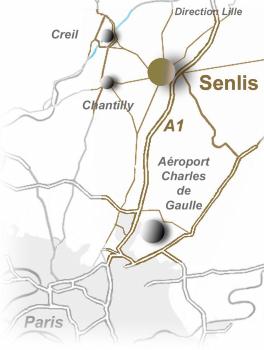
Copyright SELARL Dr Garson Pages d'information- Crédits photos : Dr Garson / Libre de droits - Mentions légales
Ce site utilise des cookies à des fins statistiques - Pour en savoir plus, cliquez ICI.
SITE RÉALISÉ AVEC WEBACAPPELLA RESPONSIVE